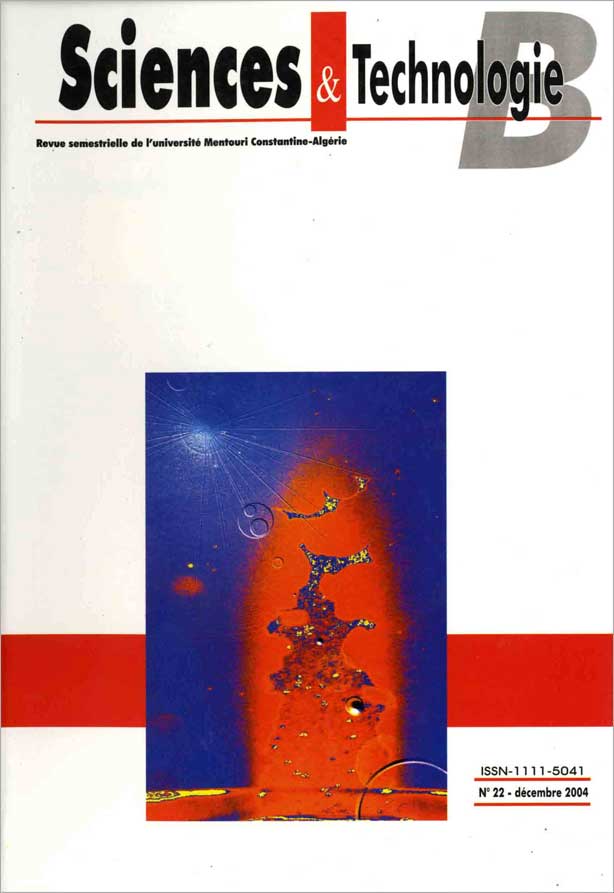EFFICACITE DES ALGORITHMES GENETIQUES PROCEDANT PAR REDUCTION SUCCESSIVE POUR L’IDENTIFICATION DES PARAMETRES
Keywords:
Algorithmes génétiques, Gaussienne, Mutation, Réduction successiveAbstract
Cet article présente un algorithme d’identification des paramètres, basé sur les algorithmes génétiques et qui procède par réduction successive du domaine de recherche des différents paramètres à identifier. Pour pouvoir étudier la convergence de cet algorithme, quel que soit le domaine de recherche initial, nous avons utilisé plusieurs intervalles initiaux et deux types de mutation : la mutation uniforme et la mutation gaussienne. L’approche proposée est testée sur un système non linéaire modélisé par des équations différentielles non linéaires représentant le système de Monod. Les résultats obtenus confirment le fait que la réduction des intervalles améliore la convergence des algorithmes génétiques.References
- Goldberg D., "Algorithmes génétiques", Edition Addison-Wesley, France, SA, (1994).
- Holland J., "Adaptation in natural and artificial systems", Ann Arbor : The university of Michigan Press, (1975).
- Sareni B., "Algorithmes génétiques standards", Rapport interne CEGELY, R-97-01, (1997).
- Macro N., "A genetic algorithm compared with a gradient-based method for the solution of an active-control model problem", Rapport INRIA N°2948, (1996).
- Yong Z. and Sannomiya N., "An improvement of genetic algorithms by search space reductions in solving large-scale flowshop problems", T.IEE Japan, Vol.121-C, N°6, (2001), pp. 1010-1015.
- Pohjanpalo H., "System identifiability based on the power series expansion of the solution", Math. Biosci., Vol 41, (1978), pp. 21-33.
- Saccomani M.P., Audoly S., Bellu G. and D’Angio L., "A new differential algorithm to test identifiability of non linear systems with given initial conditions", Proceeding of the 40th IEEE Conference on Decision and Control, Orlando, Florida USA, (2001).
- Setnes M. and Roubos H., "G.A-Fuzzy modeling and classification complexity and performance", IEEE Transactions on Fuzzy Systems, Vol.8, N°5, (2000).
- Holmberg A., "On the pratical identifiability of microbial growth models incorporating Michaelis-Menten type nonlinearities", Math. Biosci., Vol.62, (1982), pp. 23-43.
- Muller T.G, Noykova N., Gyllenberg M. and Timmer J., "Parameter identification in dynamical model of anaerobic waste water treatment", Math. Biosci., Vol.177, (2002), pp. 147-160.
Downloads
Published
How to Cite
Issue
Section
License
Les auteurs publiant dans cette revue acceptent les termes suivants :- Les auteurs détiennent le droit d'auteurs et accordent à la revue
le droit de première publication, avec l’ouvrage disponible simultanément [SPÉCIFIER LA PÉRIODE DE TEMPS] après publication, sous la licence Licence d’attribution Creative Commons qui permet à d'autres de partager l'ouvrage en en reconnaissant la paternité et la publication initiale dans cette revue. - Les auteurs peuvent conclure des ententes contractuelles additionnelles et séparées pour la diffusion non exclusive de la version imprimée de l'ouvrage par la revue (par ex., le dépôt institutionnel ou la publication dans un livre), accompagné d'une mention reconnaissant sa publication initiale dans cette revue.
- Les auteurs ont le droit et sont encouragés à publier leur ouvrage en ligne (par ex., dans un dépôt institutionnel ou sur le site Web d'une institution) avant et pendant le processus de soumission, car cela peut mener à des échanges fructueux ainsi qu'à un nombre plus important, plus rapidement, de références à l’ouvrage publié (Consulter The Effect of Open Access).


